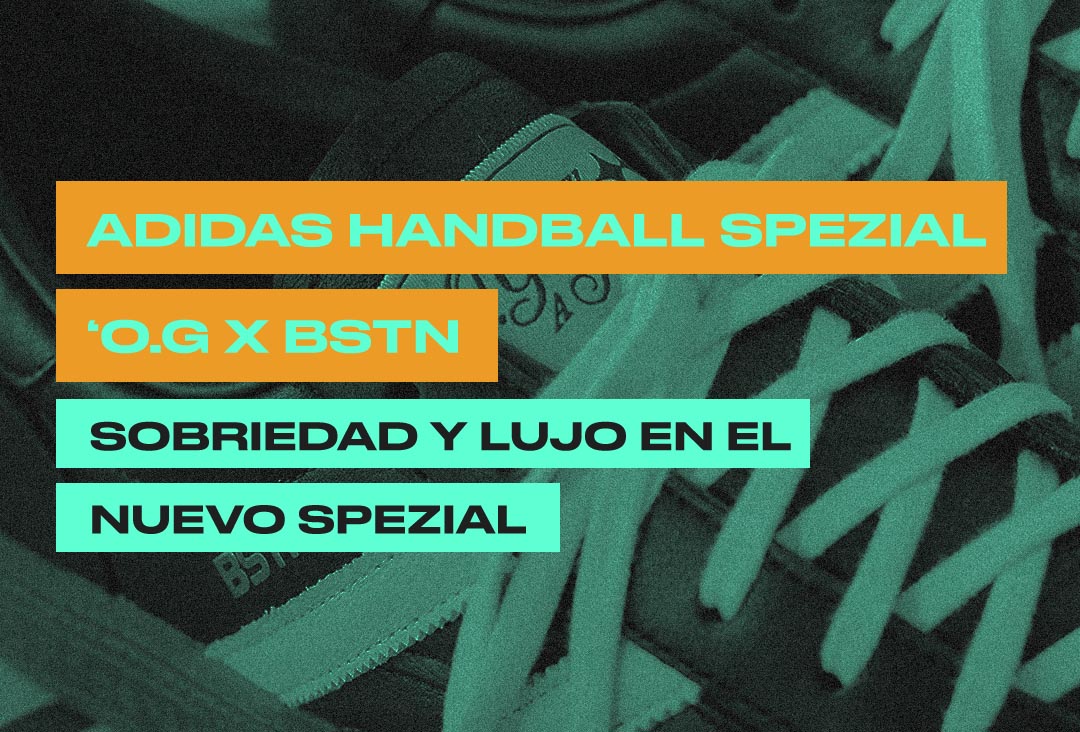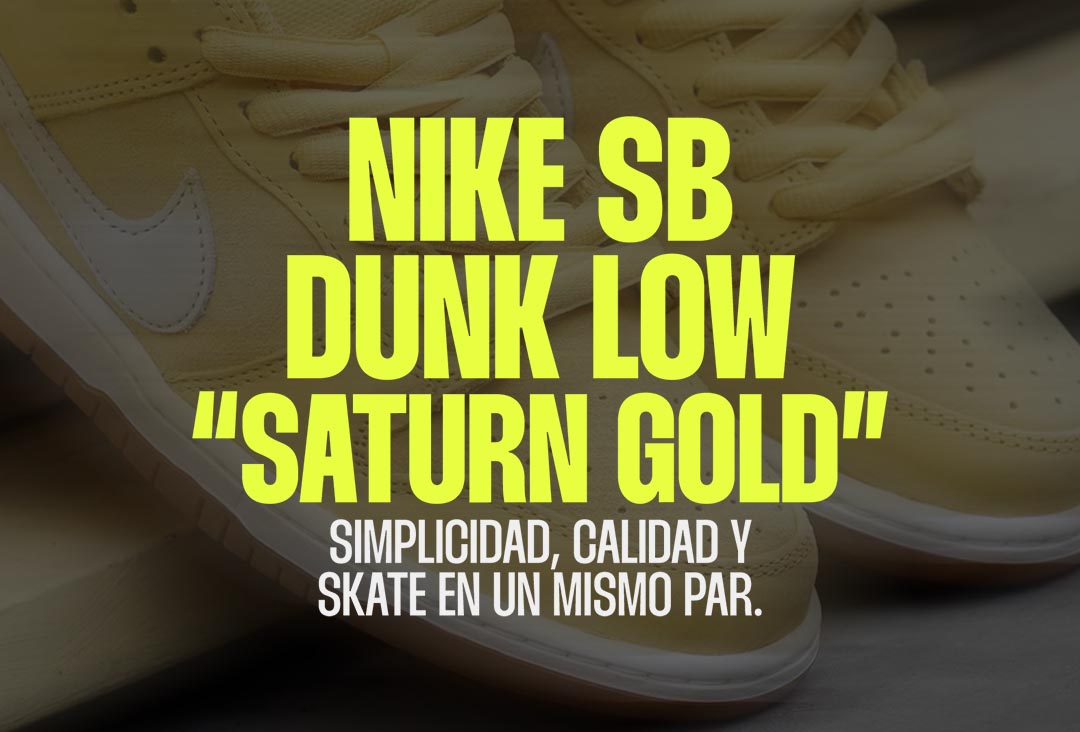Blog
Behind the design – éS TJ Rogers x Michael Morey
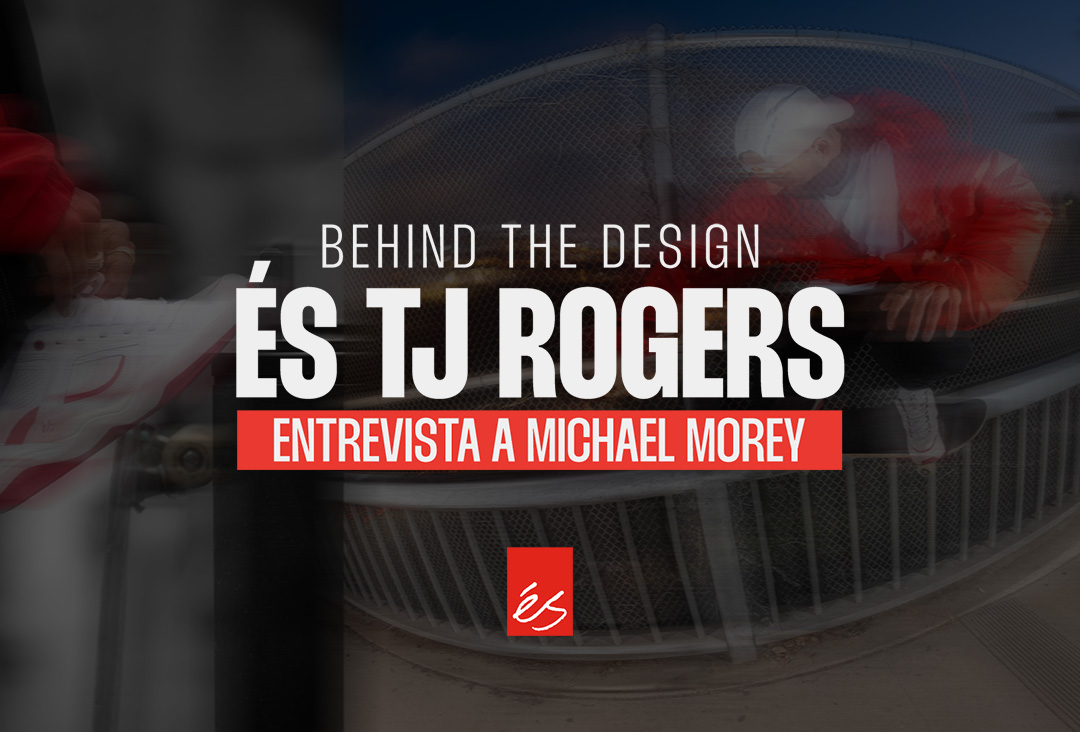
Después de más de quince años, éS vuelve a lanzar un pro model, y lo hace de la mano de TJ Rogers. El skater canadiense, reconocido por su estilo potente y su producción constante de material, se convierte en protagonista de un hito para la marca, al recibir su primer modelo profesional.
Para conocer en detalle cómo fue el desarrollo de esta zapatilla, conversamos con Michael Morey, diseñador de éS y responsable de darle forma a un proyecto que mezcla herencia, innovación y la visión personal de TJ. En esta entrevista, Michael comparte el detrás de escena del proceso creativo, las inspiraciones, los desafíos y la importancia de traer de vuelta un pro model a la historia de éS.
SOBRE EL PROCESO Y LA COLABORACIÓN
1. ¿Cómo comenzó el proceso de diseño del pro model de TJ? ¿Fue un pedido de él o una propuesta de la marca?
El proceso comenzó hace casi dos años. En ese momento estábamos empezando a planear la línea para la segunda mitad de 2025.
2025 es un año importante, ya que marca los treinta años de éS. Así que, para la colección de primavera, trajimos de vuelta la Accel en su forma original de 1995. Esa fue una decisión obvia ya que la gente la venía pidiendo hace mucho.
Mientras esto sucedía, TJ también estaba atravesando lo que pensábamos que era un período bastante prolífico. Pero cuanto más lo analizábamos, más nos dábamos cuenta de que en realidad ese es simplemente su ritmo natural: siempre produciendo al máximo. Así que terminó siendo otro movimiento obvio. TJ es la elección perfecta como skater para desarrollar un pro model; su nivel de skate habla por sí solo, su producción constante de footage y su increíble habilidad sobre la tabla también; pero más allá de eso, es una persona sencilla, auténtica, con una historia para contar y un amor puro por el skateboarding.
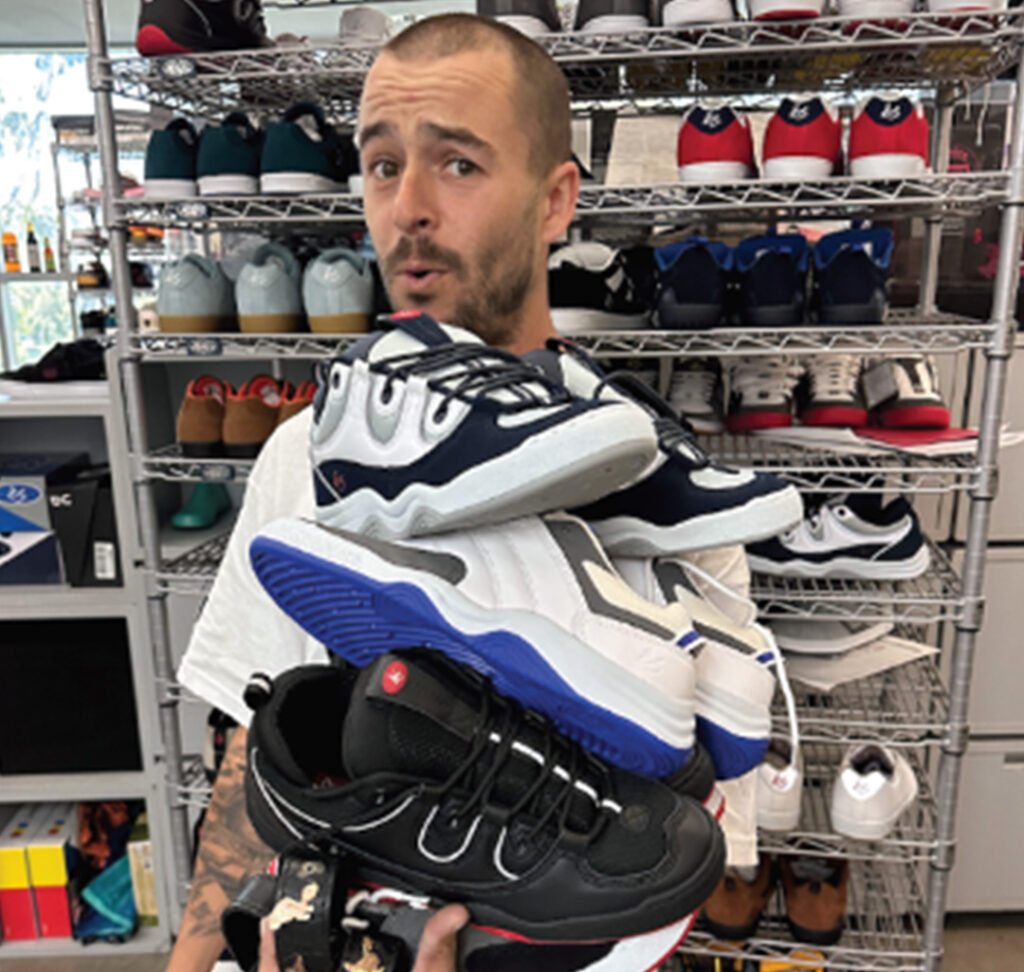
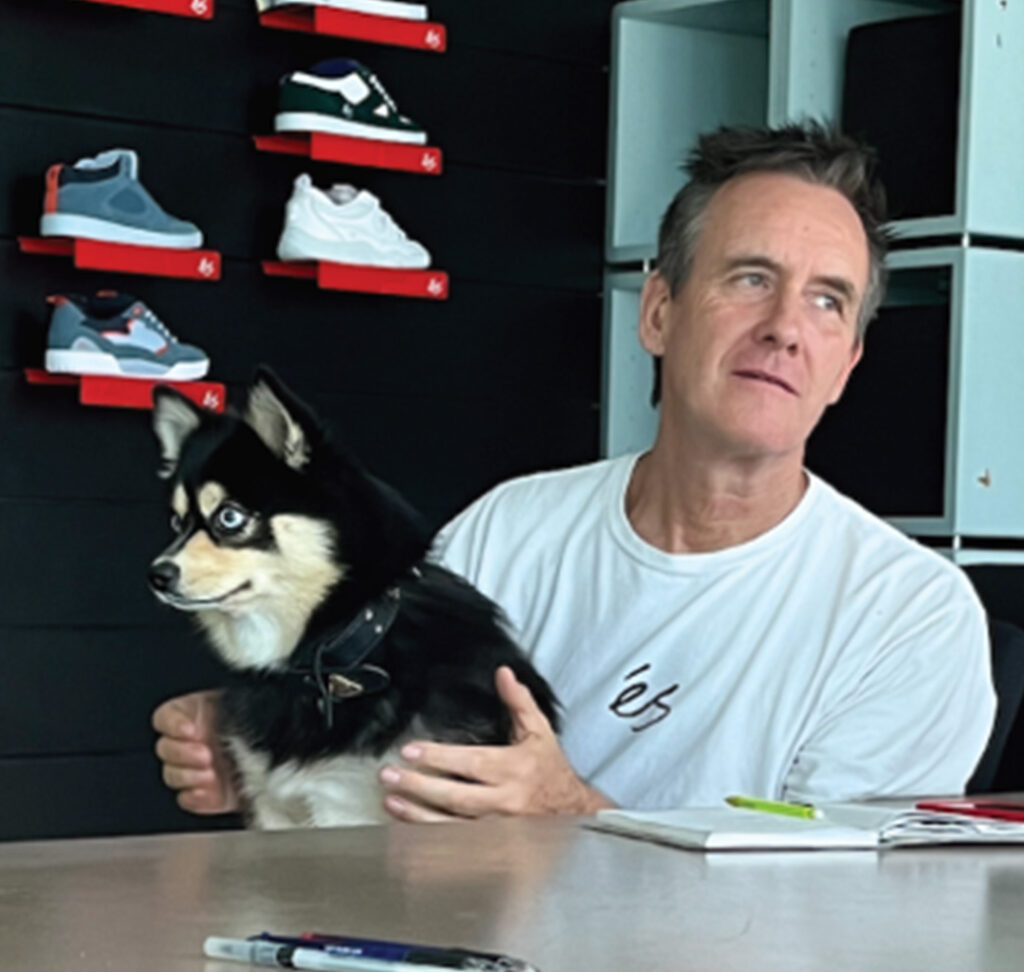
2. ¿Qué tanto estuvo involucrado TJ en el desarrollo? ¿Hubo ideas clave que vinieran directamente de él?
TJ estuvo muy involucrado en el diseño y desarrollo de la zapatilla. Desde la primera reunión con el equipo para hablar de la oportunidad, trajo un montón de ideas inspiradas tanto en modelos actuales como en referencias de archivo. Hablamos mucho sobre lo que le gustaba y lo que se podía mejorar para que la zapatilla se ajustara mejor a sus necesidades.
Un ejemplo concreto que recuerdo es que a TJ le encantaba el sistema de cordones internos de la Evant, pero sentía que el refuerzo y el panel lateral perdían la forma demasiado rápido. Para corregirlo, señaló un modelo de éS del 2006 llamado Cradle, que tenía un ribete textil ajustado en la parte superior del lateral y la lengüeta, además de una pieza moldeada en el refuerzo de los cordones que le daba más estructura.
Mejoramos esto usando un molde TPR inyectado directamente en el refuerzo de cordones para dar soporte sin sumar volumen extra. Una idea estética que TJ aportó fue usar la etiqueta ovalada clásica en la lengüeta, pero con su nombre. Fue muy claro en expresar lo importante que era para él sumarse a la lista de skaters que han tenido un pro model con éS – Koston, Penny, Muska, Creager, entre otros. Así que revivir ese detalle fue su manera de rendir homenaje a las leyendas.
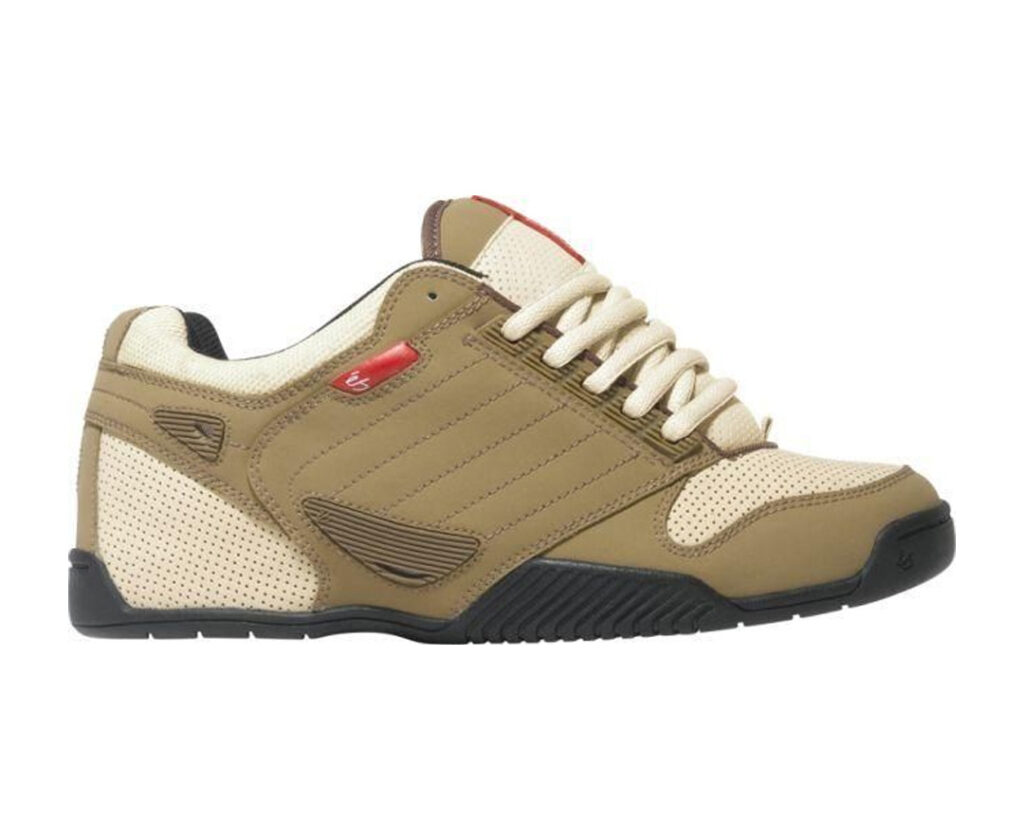
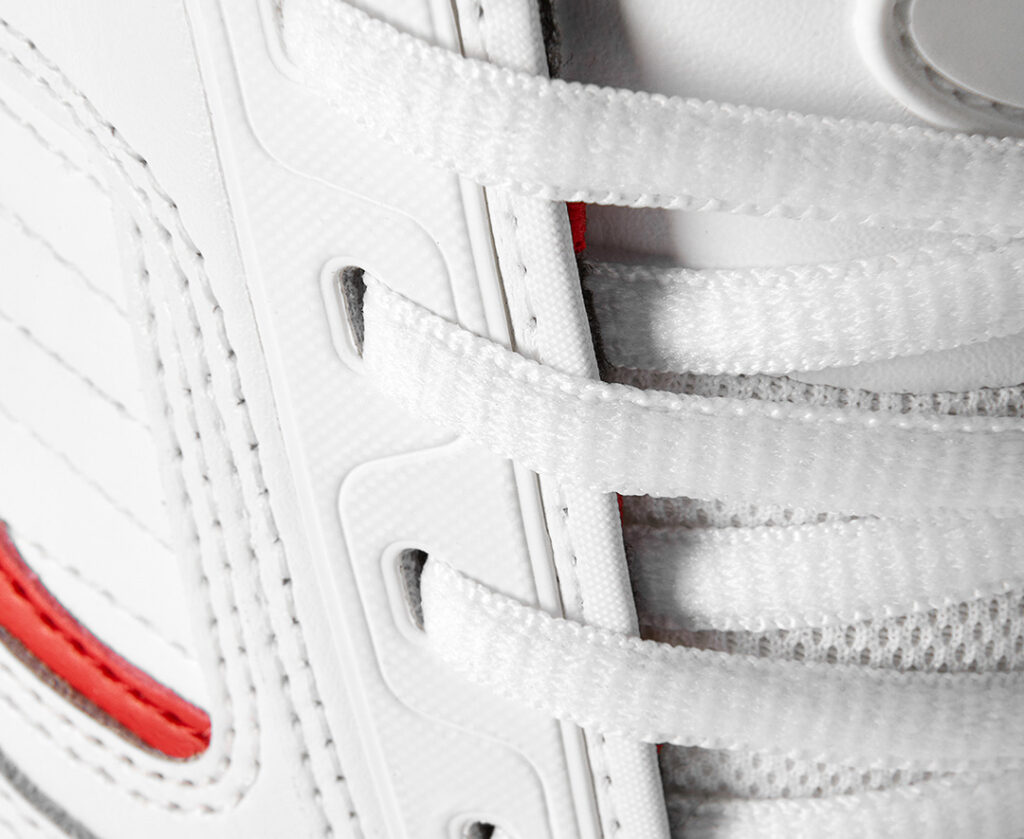
3. ¿Cuánto tiempo llevó pasar de los primeros conceptos al producto final?
A pesar del diseño detallado, fue un proceso de desarrollo bastante directo. Desde los primeros bocetos, reducimos opciones hasta dar con un diseño en el que confiábamos y avanzamos desde ahí.
Durante este tiempo, TJ y yo hablamos mucho por FaceTime. Cada vez que llegaba una nueva muestra, se la enviábamos para que la probara y luego nos conectábamos para hablar sobre lo que funcionaba y lo que había que ajustar.
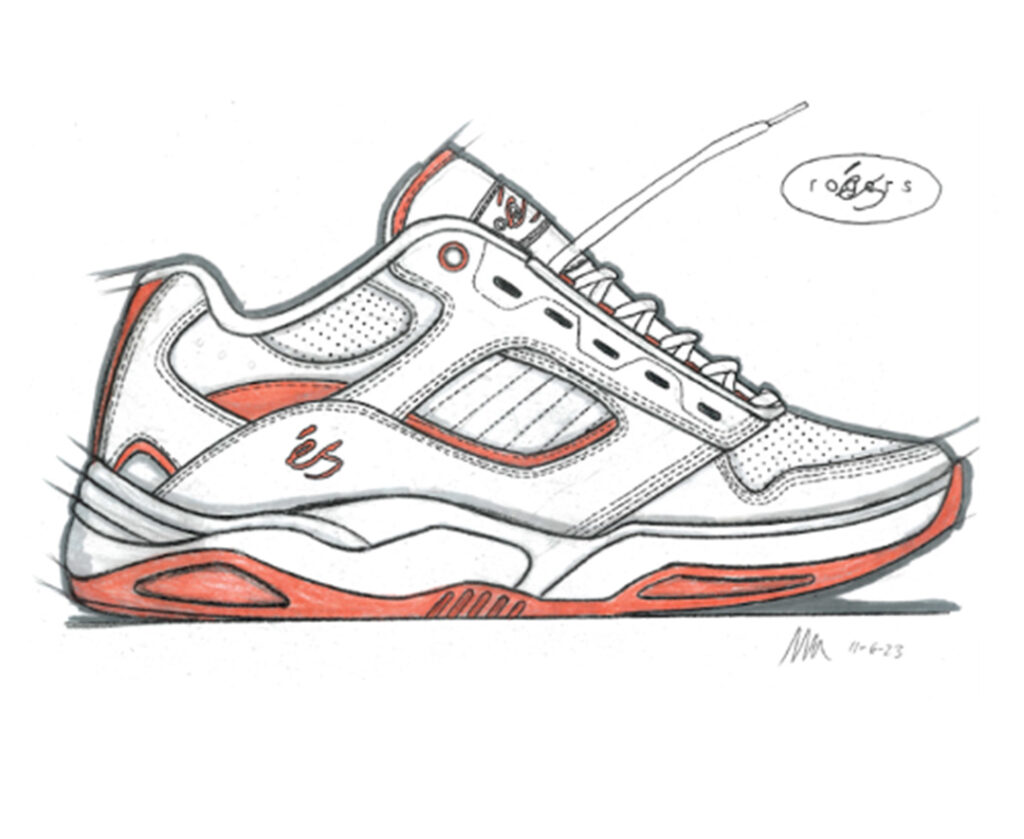
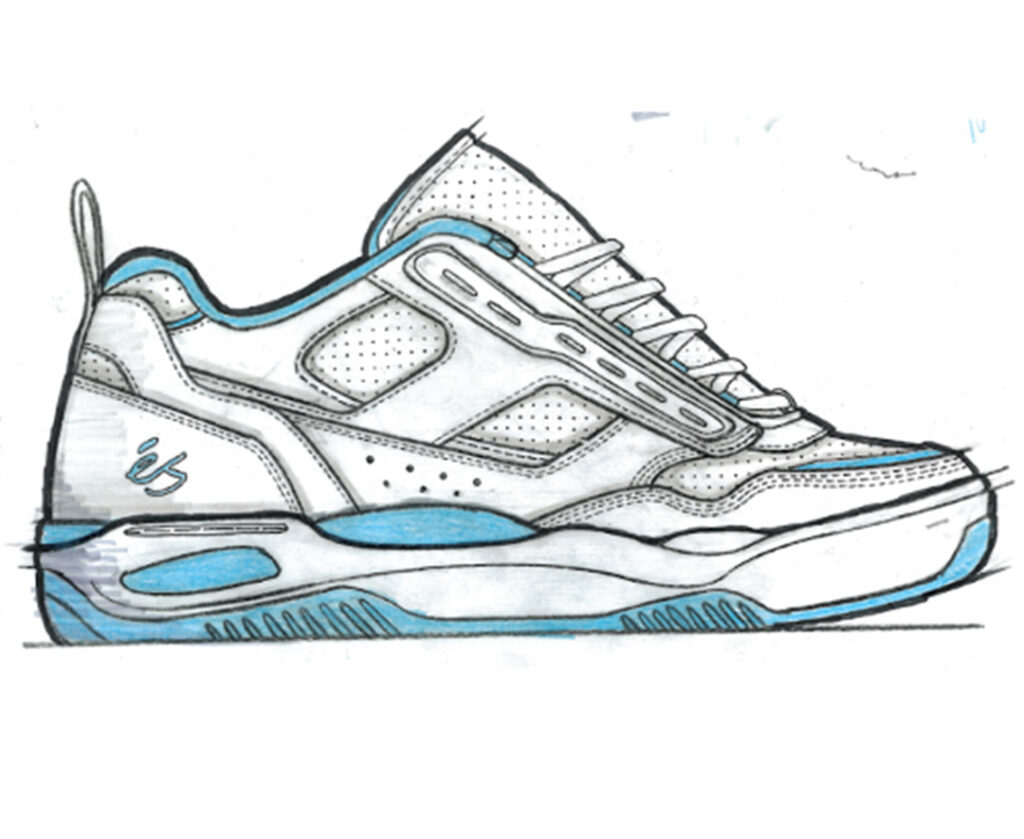
4. ¿Hubo muchas versiones descartadas o prototipos antes de llegar a la silueta final?
No demasiadas, pero el diseño original tenía una ventana en el lateral de la suela para que la espuma de la mediasuela se viera, recordando a las cámaras de aire System O2 que tenían muchos modelos de éS en el pasado. Llegamos a hacer un prototipo físico de esta versión, pero durante el wear test TJ notó que esa ventana quedaba en una zona débil para los heelflips. Así que revisamos el molde de la suela para cerrarla, lo que mejoró la estabilidad y la durabilidad.
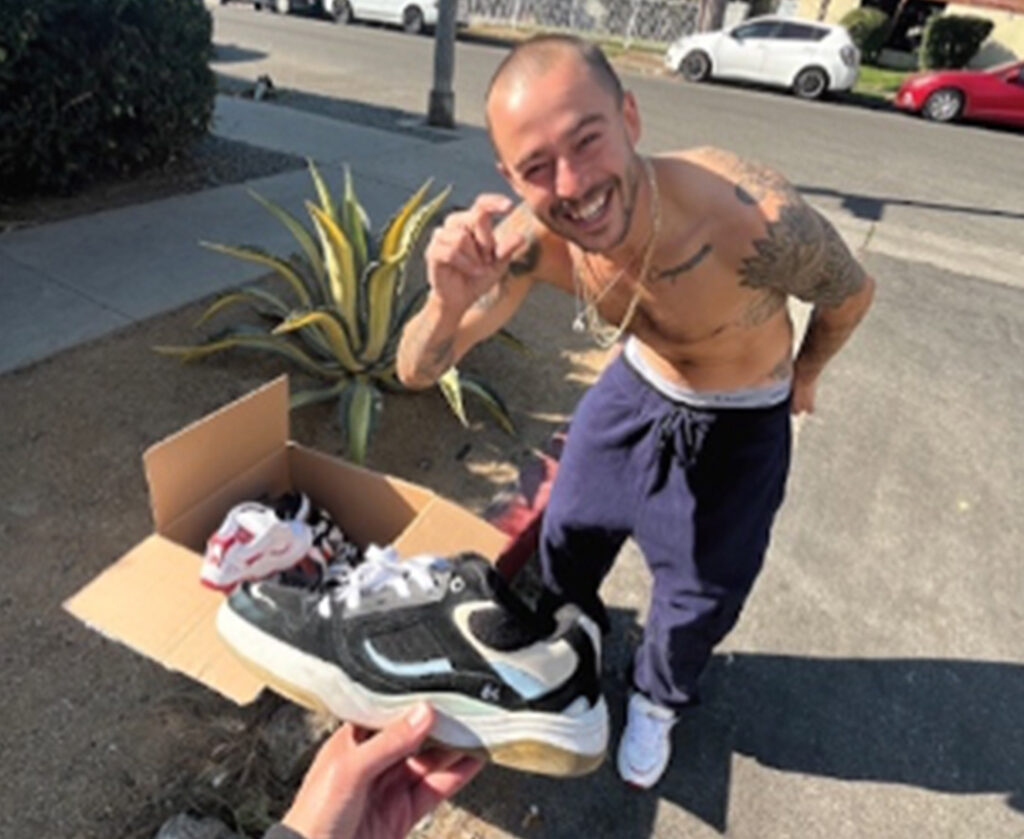
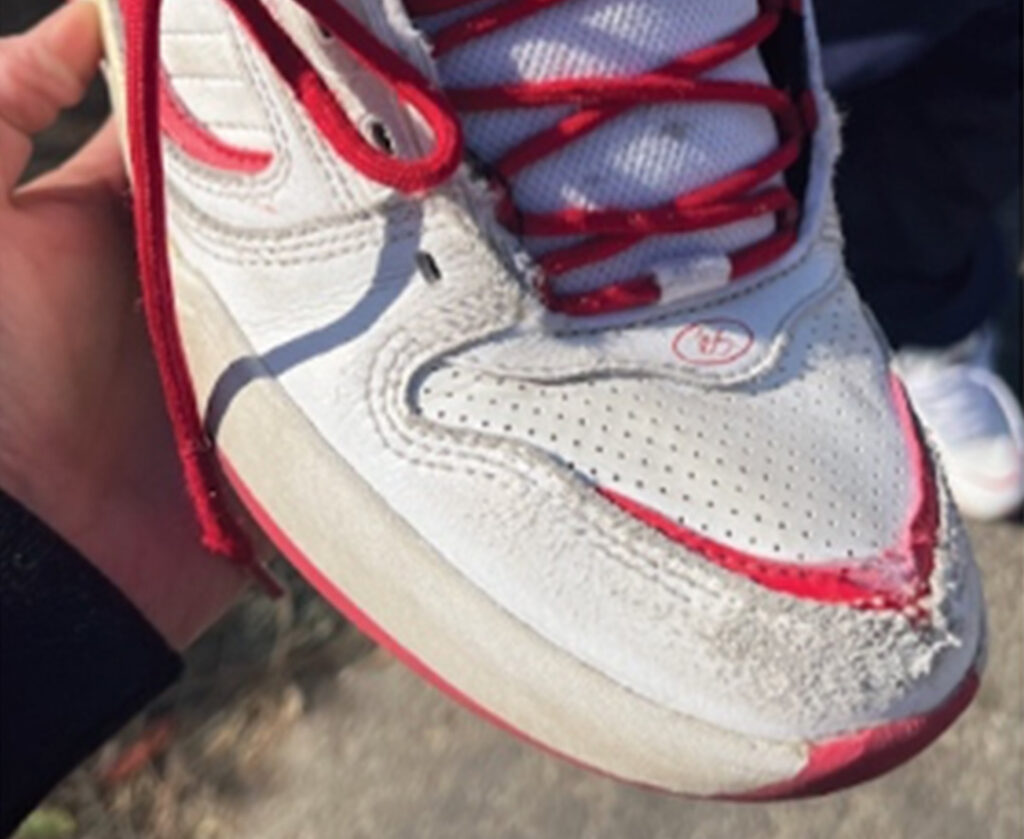
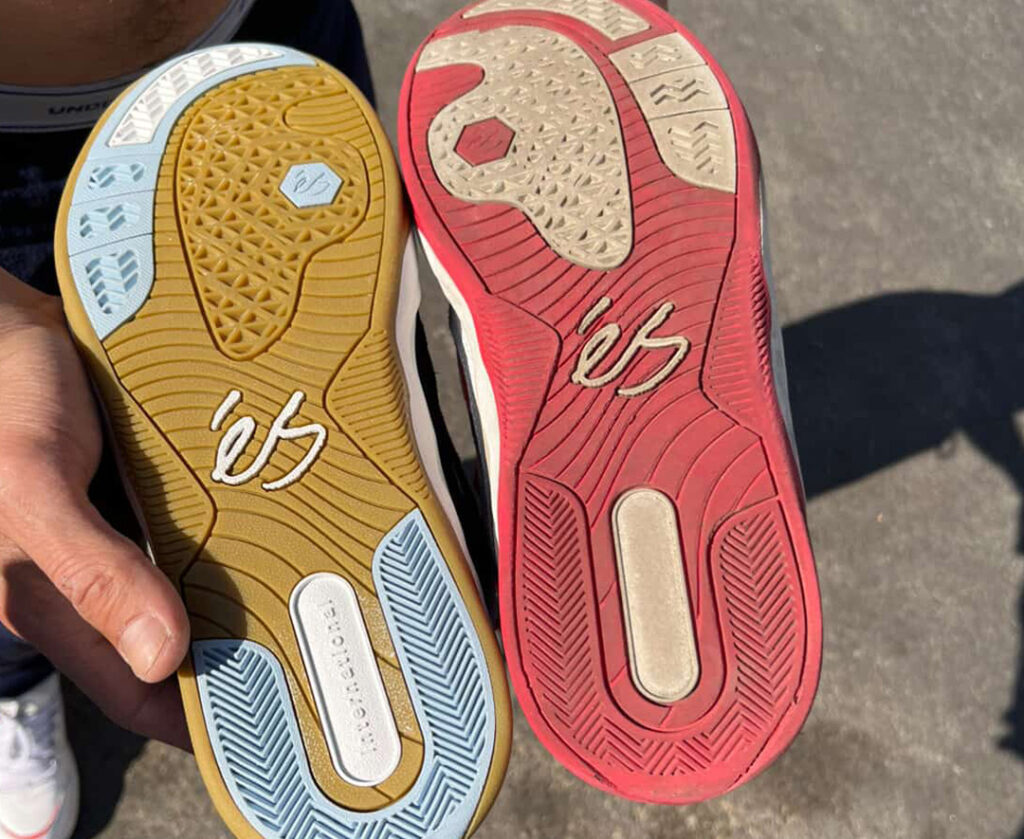
5. ¿Qué aspectos del skate de TJ buscaban reflejar en el diseño?
El skate de TJ es rápido, emocionante, fluido y confiado. Ya sea armando una línea técnica de flips y manuals o tirándose por un gap enorme, lo hace con mucha seguridad. También se viste con mucha actitud, sin miedo a usar colores fuertes o ropa oversized. Queríamos diseñar una zapatilla que, apenas alguien la vea en una estantería, entienda que va a durar mucho y va a proteger sus pies. La superposición de paneles y el uso de líneas curvas se eligieron para transmitir esa mezcla de actitud expresiva y confianza frente al riesgo.
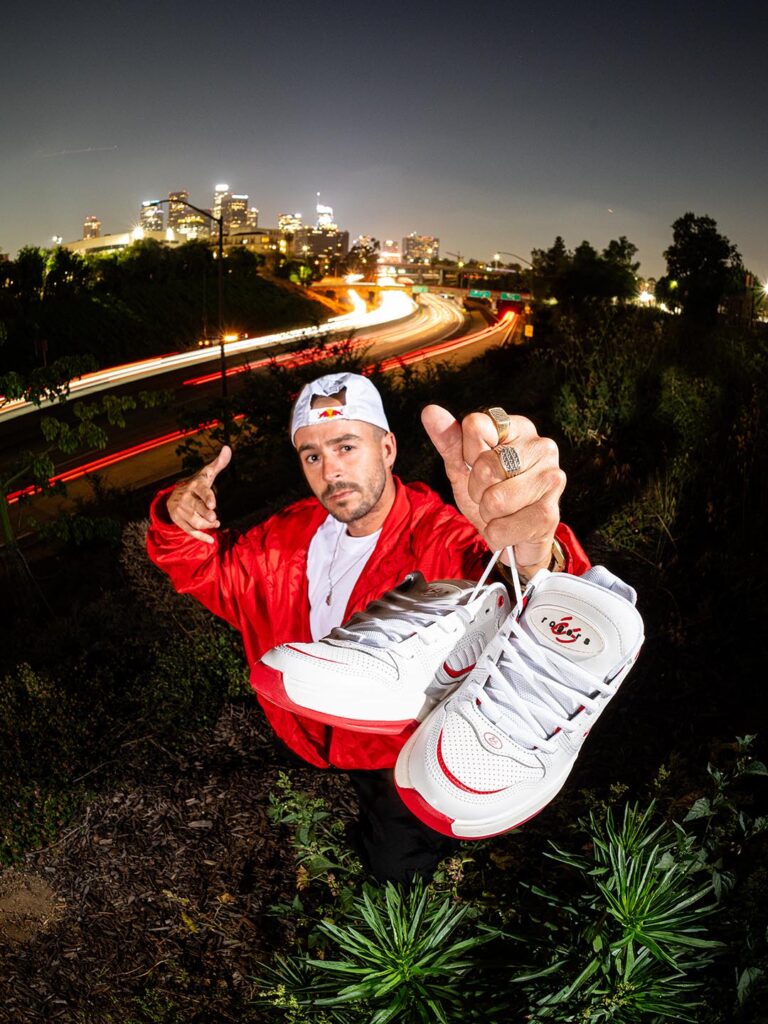
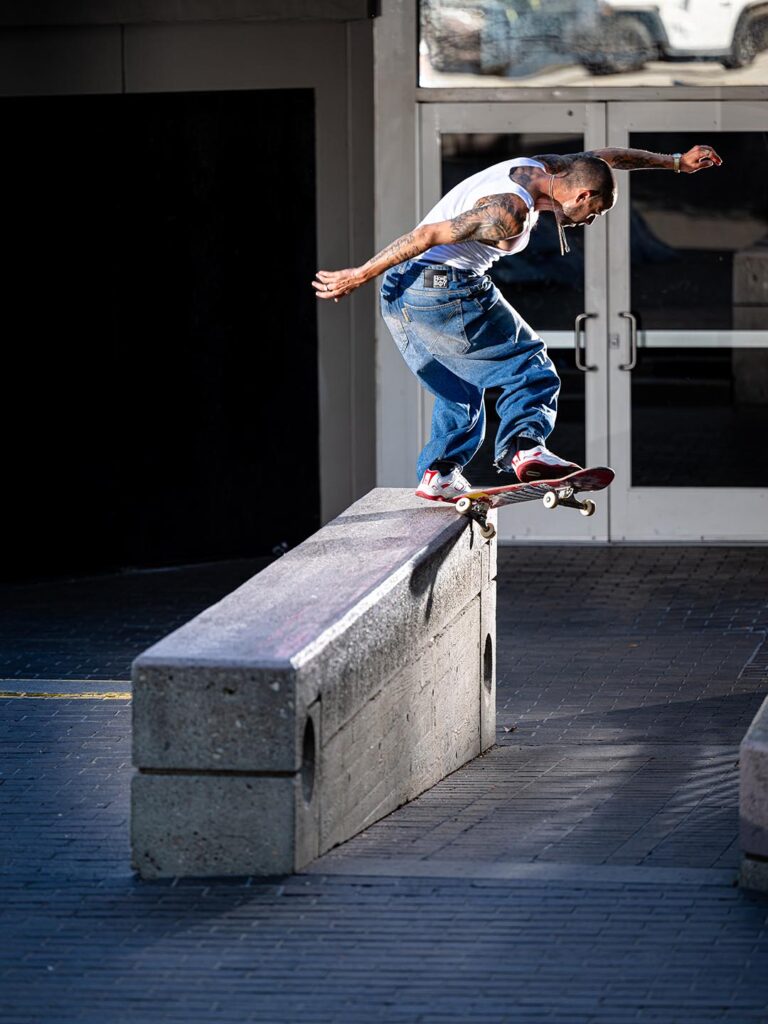
SOBRE EL DISEÑO Y LA FUNCIONALIDAD
6. ¿Cuál fue la inspiración estética detrás de la silueta? ¿Hubo referencias a modelos pasados de éS?
Queríamos crear algo atlético y nostálgico, pero atemporal. Hubo mucha inspiración de modelos clásicos de éS. Como mencioné antes, TJ desde el inicio quería integrar detalles de modelos pasados y actuales. El refuerzo de cordones viene del Cradle. La malla en el talón del Koston 3. Los detalles ondulados en el lateral de la suela recuerdan a la Evant (que también inspiró el sistema opcional de cordones ocultos). La suela toma el hex pattern del Quattro en el antepié para dar flexibilidad y tacto. El clásico patrón herringbone se usó en el antepié lateral y talón para dar más grip donde hace falta. Y la parte media de la suela tiene un patrón ondulado inspirado en el Creager.
7. ¿Qué materiales y tecnologías clave eligieron, y por qué?
Para el lanzamiento hicimos un colorway en cuero (Blanco/Rojo) y otro en gamuza (Negro/Blanco). La versión en cuero tiene un look más clásico y atlético, inspirado tanto en los colores de éS como en las raíces canadienses de TJ. La versión en gamuza era indispensable, ya que sigue siendo el material favorito de la mayoría de los skaters, y su colorway se inspiró en el pelaje del perro de TJ, BB.
En cuanto a tecnología, presentamos un nuevo compuesto de espuma en el modelo de TJ llamado E-BOUND. Comparado con una mediasuela de PU moldeado tradicional, la espuma E-BOUND es 30% más suave, 20% más resistente y tiene una vida útil 5,5 veces mayor que la EVA moldeada (el estándar en la mayoría de las zapatillas de skate actuales). Es súper esponjosa y excelente para absorber impactos.
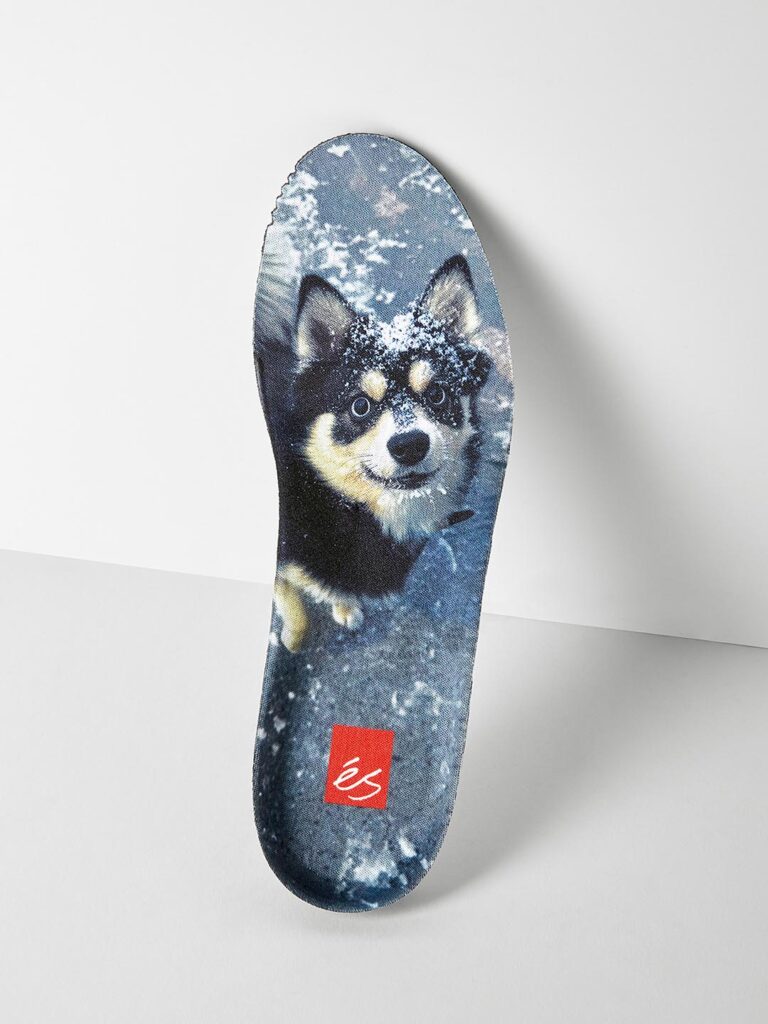
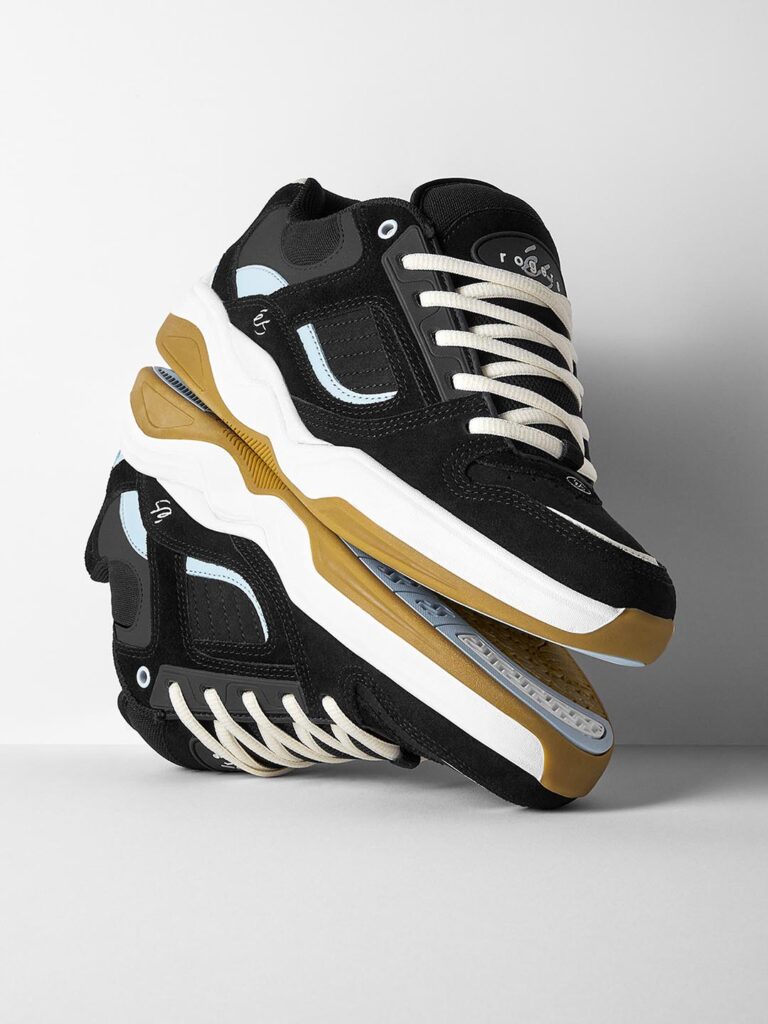
8. ¿Cómo equilibraron el rendimiento técnico con el atractivo lifestyle que muchos skaters buscan hoy?
Es un equilibrio delicado: si hacés algo con mucho estilo pero que no aguanta para patinar, no es una skate shoe; pero si hacés la zapatilla más técnica del mundo, probablemente se vea demasiado futurista.
Ambos aspectos son clave. En un pro model, hay que verlo todo a través de la mirada del skater. El look de la zapatilla de TJ es audaz. Algunos dirán que es complicada o muy recargada; y tal vez no sea para ellos – y está bien. Algunos skaters prefieren algo simple y fino con pocos paneles, y también hacemos eso. Lo más importante es que represente el estilo y la esencia de TJ.
9. ¿Cuál fue el mayor desafío de diseño? ¿Y qué parte disfrutaste más?
El mayor desafío, que también fue lo más divertido, fue combinar todas las influencias y detalles de los modelos favoritos de TJ. Tomar elementos de siluetas icónicas como el Koston 3 y lograr que la zapatilla no se vea como una copia fue complicado. Estoy muy orgulloso de haberlo logrado y de haber creado un modelo que se siente familiar, pero con una vibra única de TJ.
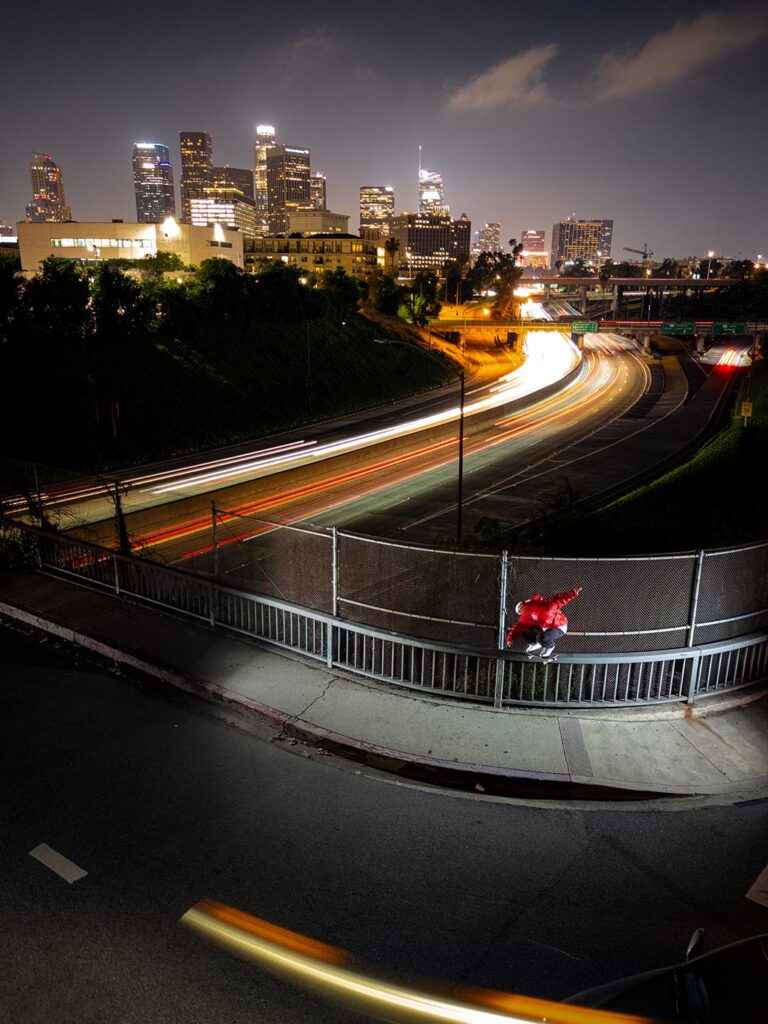
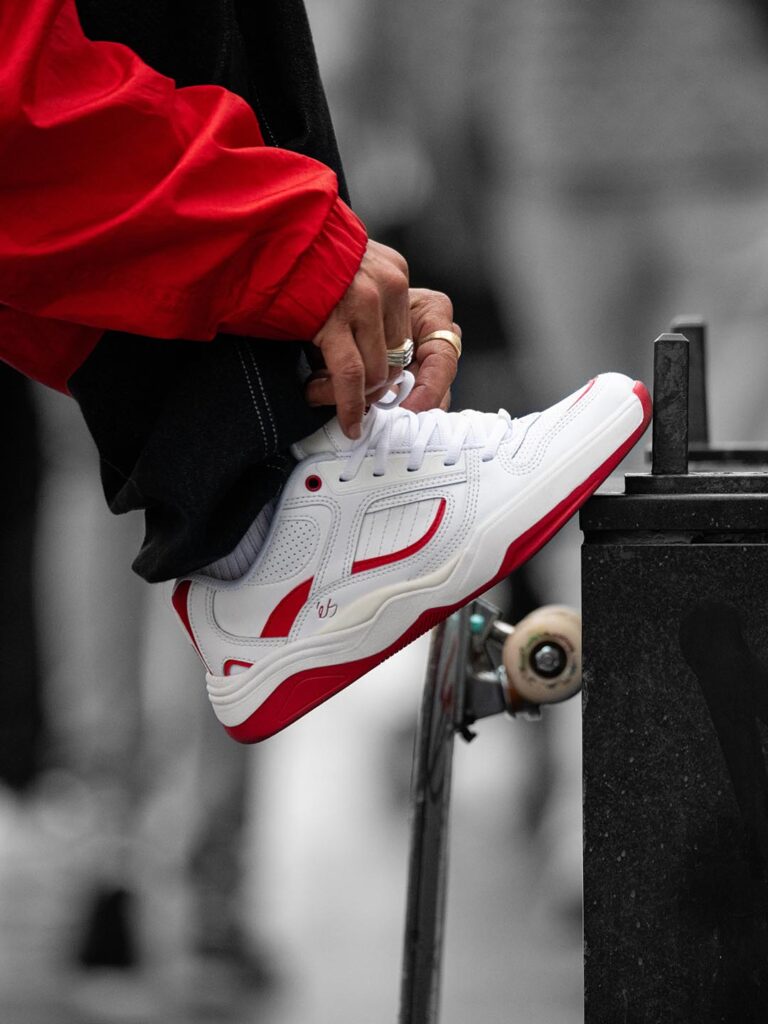
10. ¿En qué se diferencia este modelo de otros actuales de éS?
La respuesta simple es: ¡es realmente el pro model de TJ! Cada decisión –desde el diseño del upper hasta el color y la suela– se tomó en conjunto con él. En cuanto a rendimiento, la mediasuela E-BOUND es el gran diferencial. Otros detalles interesantes son el refuerzo extra en la puntera y los cordones ocultos de largo completo.
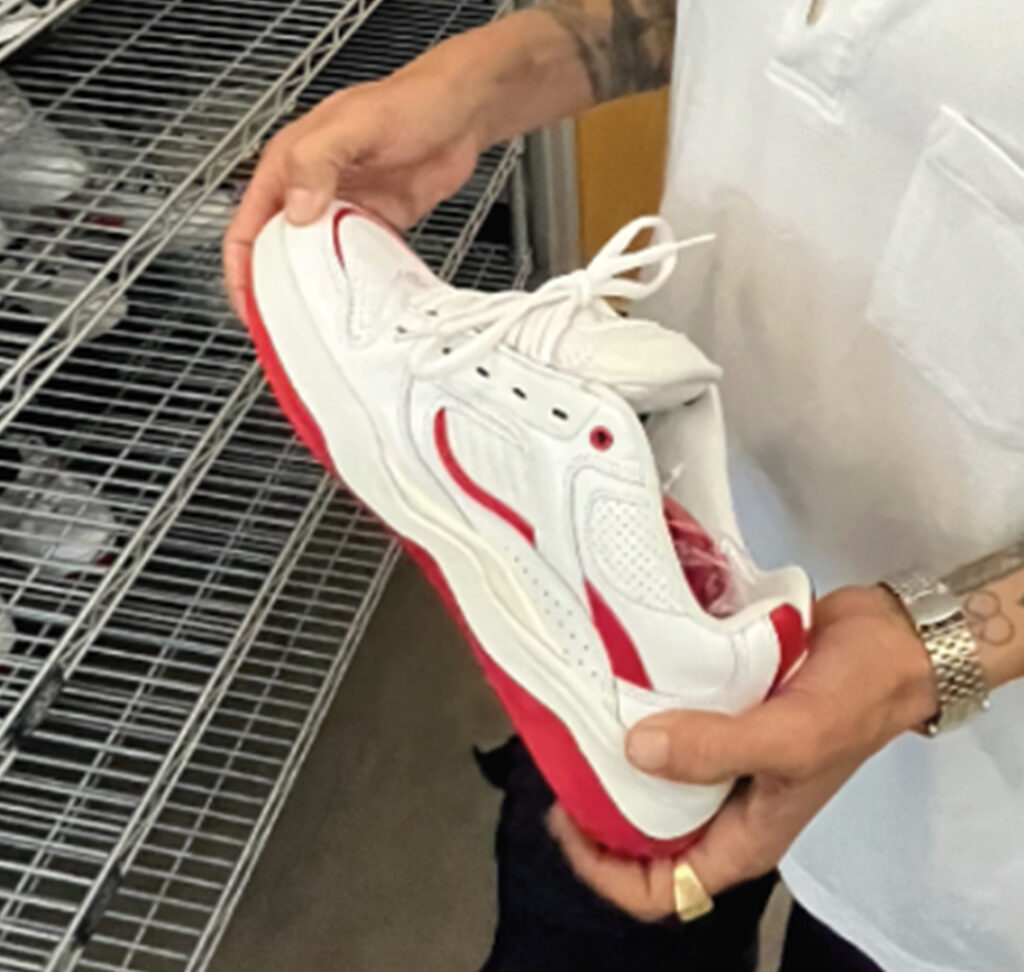
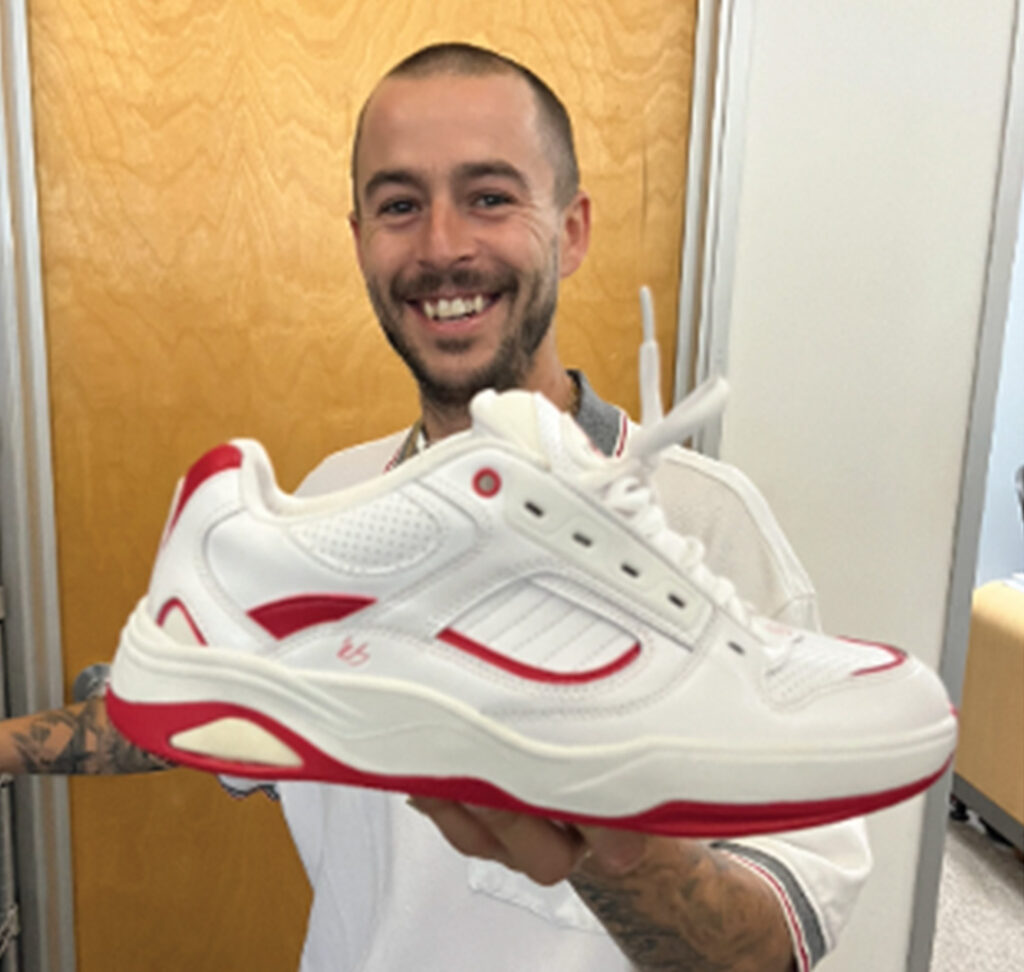
SOBRE ÉS Y EL CONTEXTO
11. ¿Qué significa para vos ser parte del primer pro model de éS en más de 15 años?
¡Uf, cuánto tiempo tenés? Jaja. En pocas palabras, es un enorme honor.
Recuerdo que el Koston 7 fue una de mis primeras zapatillas de skate, y después patiné muchos de los modelos pro que siguieron (Danny Garcia, Bobby Worrest, John Rattray, Mike Anderson, entre otros). Yo crecí en el midwest, lejos de la industria, y trabajar en zapatillas de skate era un sueño que parecía imposible. Así que poder trabajar con TJ para crear su propio pro model –que además era un sueño de él– es un momento muy especial y redondo para mí.
12. ¿Cómo fue traer de vuelta un pro model para una marca con tanta herencia como éS?
La verdad, como dije antes, es un sueño hecho realidad. Desde que empecé en éS, empujaba para que volvieran los modelos pro. Tenemos un equipo increíble de skaters talentosos y dedicados, y TJ representa perfectamente los valores de la marca: estilo, progresión y amor por el skateboarding. Estoy muy agradecido de haber sido parte de esto. Fue mucho trabajo, pero también muy divertido poder meterme en los detalles con uno de los mejores skaters que conozco.
13. ¿Dónde creés que encaja esta zapatilla dentro de la historia de siluetas icónicas de éS?
Creo que encaja perfectamente en el legado. Tiene guiños al pasado y la historia de la marca, pero también su propia actitud. Respeta a los OGs, pero no se siente como una retro, se siente como una zapatilla de skate actual. Para ser sincero, este es uno de los proyectos de mi carrera de los que más orgulloso estoy, justamente por eso.
SOBRE EL FUTURO Y LA RECEPCIÓN
13. ¿Qué esperás que sientan los skaters cuando se las pongan por primera vez?
En pocas palabras: confianza. Cuando te ves bien, te sentís bien, y cuando te sentís bien, patinás bien. También espero que se sorprendan de lo cómodas que son.
14. ¿Ya hay planes para futuras versiones, colorways o evoluciones del modelo?
¡Absolutamente! Tenemos una colaboración muy buena con este modelo que saldrá antes de fin de 2025, así que estén atentos. Y también se vienen nuevos colorways para Holiday.
Por último, quiero agradecer el tiempo y el espacio para darle luz a este proyecto. ¡Estamos muy orgullosos de él!
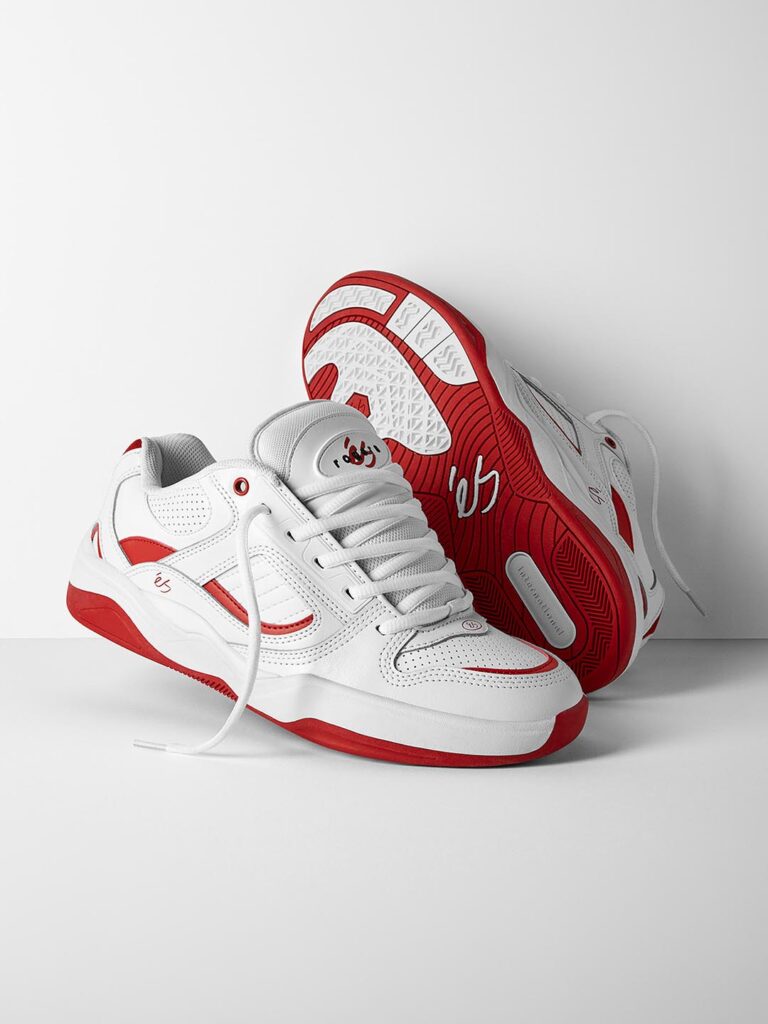
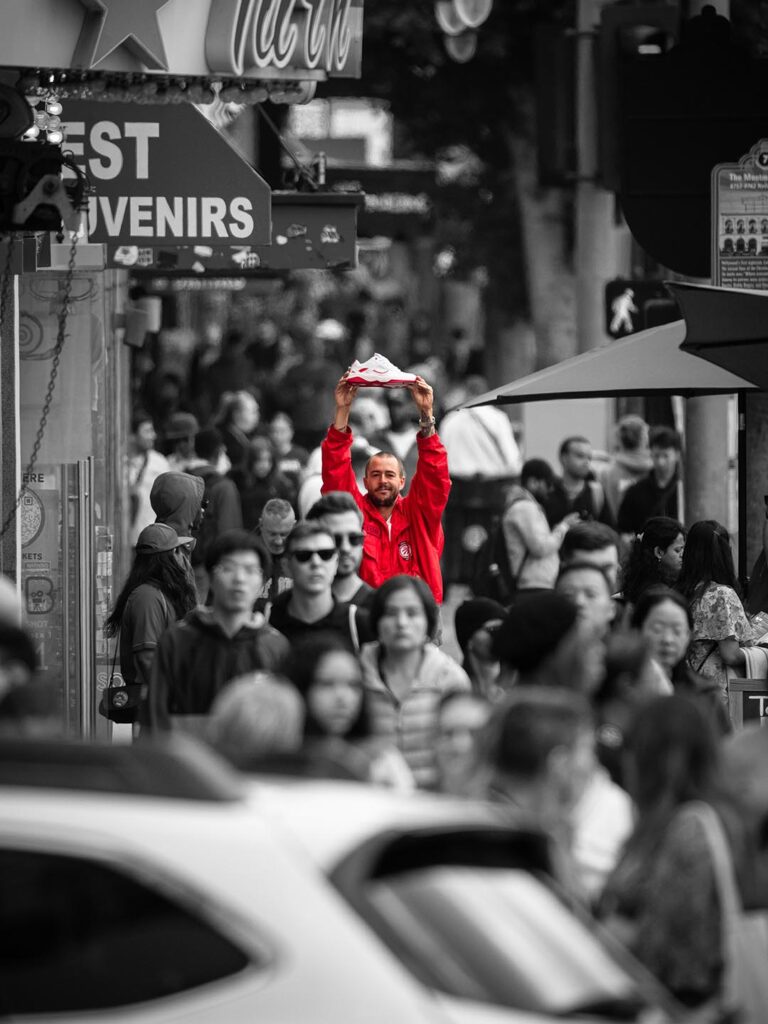
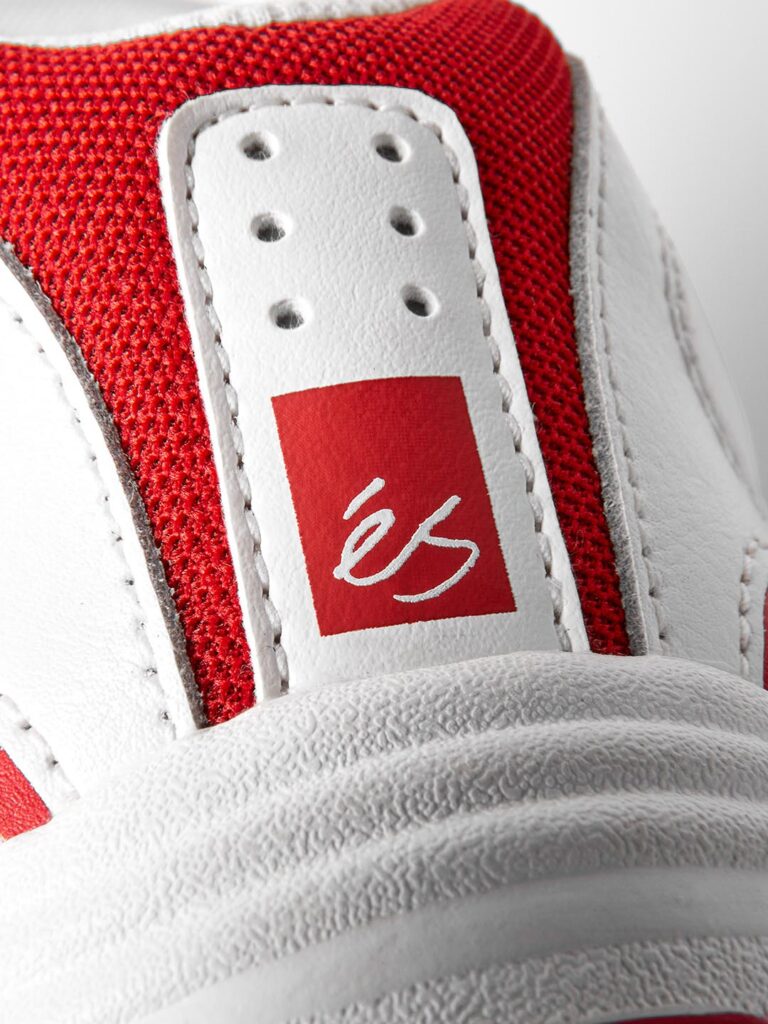
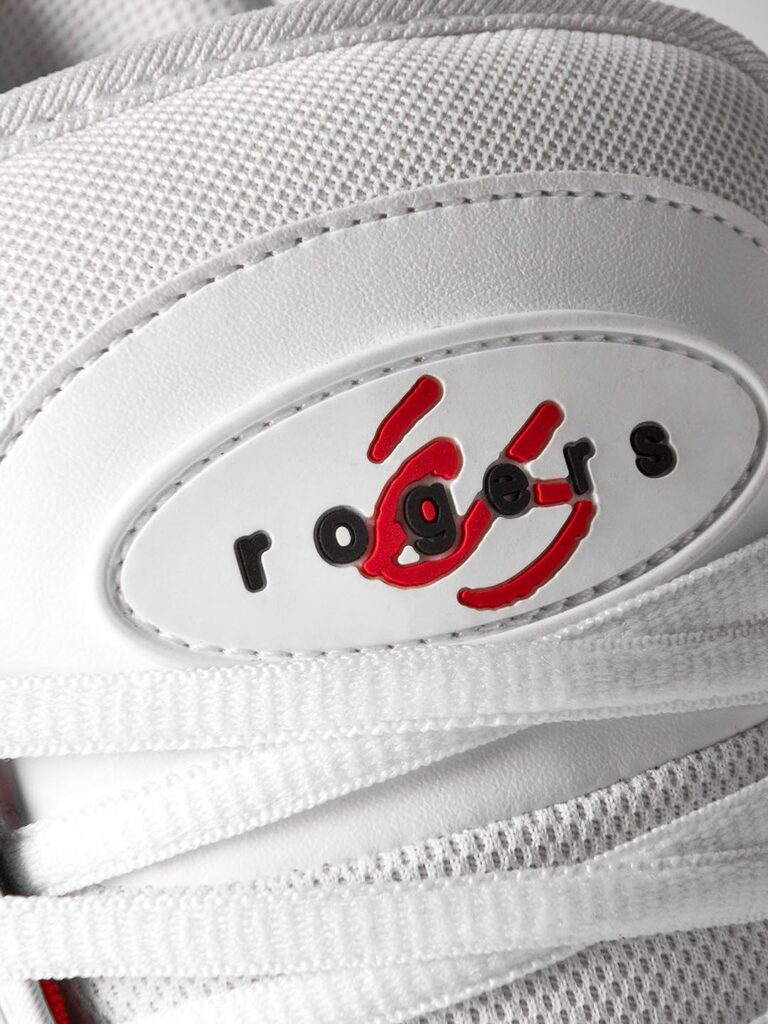
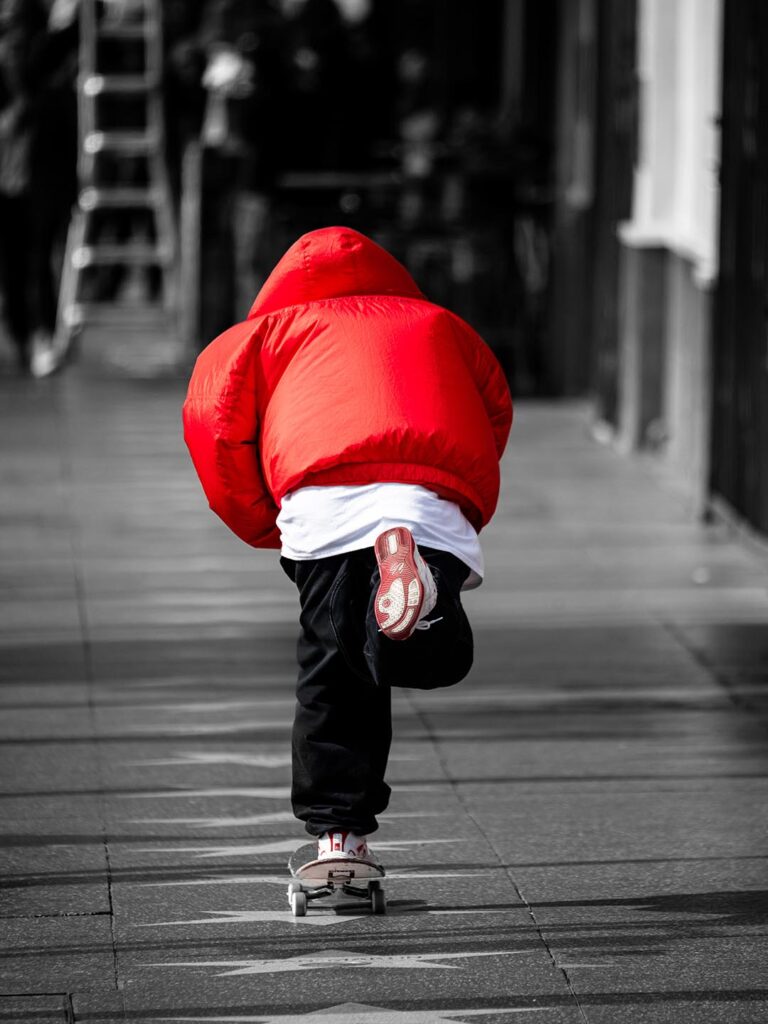
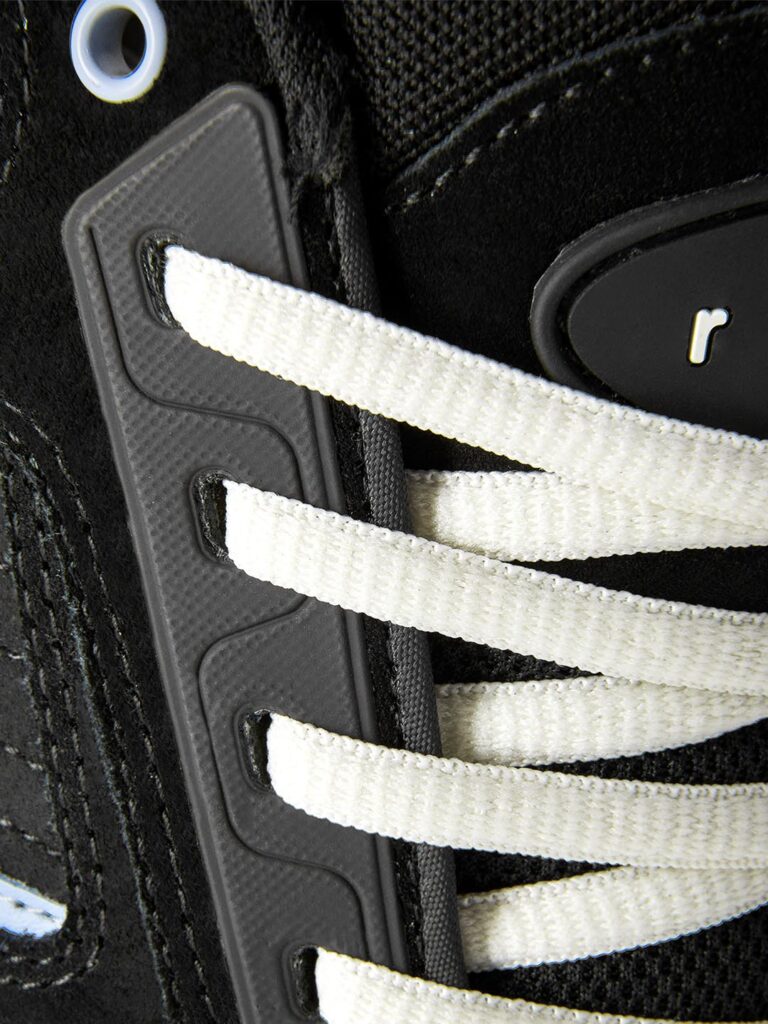

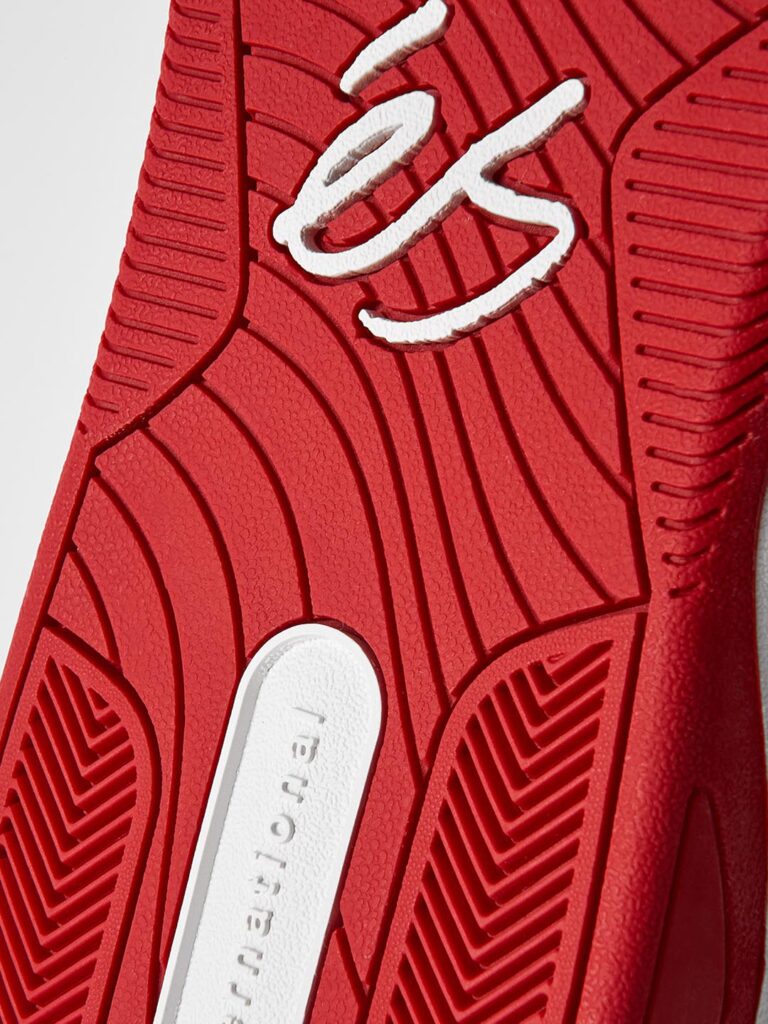
After more than fifteen years, éS is bringing back a pro model, this time with TJ Rogers. The Canadian skater, known for his powerful style and relentless output, becomes the face of a milestone for the brand with his very first signature shoe.
To get an inside look at how this project came to life, we spoke with Michael Morey, éS designer and the mind behind turning this idea into reality. In this interview, Michael shares the behind-the-scenes of the creative process, the inspirations, the challenges, and the importance of bringing a pro model back into the history of éS.
ABOUT THE PROCESS AND COLLABORATION
How did the design process for TJ’s pro model begin? Was it a request from him or a proposal from the brand?
The process began almost two years ago. At that time, we were beginning to plan the line for the second half of 2025.
2025 is a big milestone; marking thirty years of éS. So, for Spring we brought back the Accel in its original 1995 form. That one was kind of a no-brainer as people had been asking for so long.
While this was happening, TJ has also been going through what we thought was a fairly prolific period. But the more we looked at it, the reality was that this is just how he operates – output dial turned up all the time. So it ended up being another no-brainer. TJ is an obvious choice as the right skater to do build a pro shoe with; his skating obviously speaks for itself, his constant output of footage and insane ability on the board, too – but beyond that, he’s just a real, down-to-earth dude with a story to tell on top of his pure love for skateboarding.
How long did it take to go from the first concepts to the final product?
Despite the detailed design of the shoe, it was a fairly straightforward development process. From initial sketches, we narrowed down to a design that we felt confident in and went from there.
TJ and I talked a lot on FaceTime during this period. When a new sample would come in, we would send them to TJ to test and then get on a call and talk through what worked and what needed adjustment.
How involved was TJ in the development?
Were there any key ideas that came directly from him? TJ had a lot of involvement with the design and development of the shoe. From our initial meeting with the team to discuss the opportunity, he came to the table with a bunch of ideas pulling from current favorites and some references from the archives. We talked at length about what he liked and what could be improved to make a better shoe for his needs.
One specific example I recall is that TJ loved the internal lacing on the Evant, but felt like the eyestay and quarter panel lost their shape too quickly. To correct this, he pointed to an old éS model from 2006 called the Cradle which had a tight textile piping that ran along the top of the quarter and throat, as well as a molded piece on the eyestay that added some structure to the shoe.
We improved this by using a direct-inject TPR mold on the eyestay to give reinforcement to the area without adding extra bulk. An aesthetic idea that TJ brought to the table was using the OG oval tongue label with his name on it. He was very vocal as to how big of a big deal it was to him to be added to the list of names that have had a signature shoe with éS– Koston, Penny, Muska, Creager, and so on…So, reviving this detail was his way of paying his respect to the legends.
Were there many discarded versions or prototypes before landing on this final silhouette?
Not many, but the original design had a cutaway window on the lateral side of the sole so that the midsole foam could poke through the side, reminiscent of the System O2 airbags that many éS models had back in the day.
We made it all the way to a physical sample of this design, but during wear testing TJ found that the positioning of the cutaway was a weak point for heelflips. So, we revised the outsole tooling to close the window which improved stability and durability.
What aspects of TJ’s skating were you aiming to reflect in the design of the shoe?
TJ’s skating is fast, exciting, smooth, and confident. Whether he’s putting together a quick-footed ledge-to-flip-to-manual line or hucking down a big gap, he skates with a ton of confidence. He also dresses in a way that shows a lot of confidence, not afraid to rock loud colors or oversized fits. We wanted to design a shoe that when someone sees it on a shelf, they know right from the first look that this is a shoe that’s going to last a long time and protect your feet. The layering of panels and use of curvilinear lines in the design were chosen to evoke a feeling of bold expressive attitude meeting with confidence in the face of danger.
ABOUT DESIGN AND FUNCTIONALITY
What was the aesthetic inspiration behind the silhouette? Were there any references to past éS models?
We wanted to make something that looked athletic and nostalgic but timeless. There was a lot of inspiration from past éS models pulled for the design. As I mentioned earlier, from the jump TJ was keen on integrating details from past and current favorites. The eyestay construction and reinforcement come from the Cradle. The mesh spine on the back of the shoe comes from the Koston 3. The sole sidewall has some wavy layering details that are reminiscent of the Evant (which also inspired the optional hidden lace loops). For the bottom sole design, we took the inspiration from the hex tread on the Quattro and used that in the forefoot for flexibility and feel. The classic herringbone used on the lateral forefoot and heel is to add extra grip where it’s needed. Finally, the wavy tread in the midfoot was pulled from the Creager.
What key technologies or materials were chosen, and why?
For the launch season, we did one colorway in leather (White/Red) and one in suede (Black/White). The leather version gives a more classic athletic/sneaker look and the colorway was inspired by both the éS brand colors and TJ’s Canadian roots. We of course had to do a suede option for the debut because that is the tried and true favorite material for most skaters, and that colorway was inspired by the colors of TJ’s dog, BB.
As far as technology goes, we’re introducing a new foam compound in the TJ Rogers called E-BOUND. When compared to a traditional molded PU midsole, E-BOUND foam is 30% softer and 20% more supportive, and has a functional lifespan that is 5.5x longer than molded EVA foam (EVA is standard for modern skate shoes). This stuff is super spongy and great at absorbing impact.
How did you balance technical performance with the lifestyle appeal that many skaters look for today?
When it comes to performance features vs wearability, it’s a delicate balance; If you come out with something that looks dope but doesn’t hold up for skating, it’s not a skate shoe; on the other hand, if you create the most technically sound performance-driven skate shoe, it would probably look crazy.
Both aspects hold great importance. For signature shoes, the dichotomy has to be looked at through the lens of the skater. The look of TJ’s shoe is bold. Some might call it complicated or too intricate of a design; but then maybe this shoe isn’t for them – and that’s okay. Some skaters want something simple and thin with minimal paneling, and that’s okay, we make shoes like that too– the ultimate importance is something that represents TJ’s style and his flavor of skating.
What was the biggest design challenge? And which part did you enjoy creating the most?
For me, the greatest design challenge was also the most enjoyable; combining the many influences and feature points from TJ’s favorites. To pull from iconic silhouettes like the Koston 3 and not have the shoe bear an obvious resemblance to it is no easy task. I’m super proud to say that we were able to accomplish that and bring something to the market that has a familiar feeling but with its own vibe that is unique to TJ.
How does this shoe differ from other current éS models?
The easy answer is it truly is TJs signature model! Every decision made from the upper design, outsole function, and colors was made in partnership with TJ. On a performance level, the E-BOUND midsole is the standout feature. Some other cool mentions are the toecap underlay for extra durability and the full-length hidden lace loops.
ABOUT ÉS AND CONTEXT
What does it mean to you to be part of the first éS pro model in over 15 years?
Oh man, how much time do you have? Haha! To put it lightly, it’s a huge honor.
I remember growing up, the Koston 7 was one of my first skate shoes, and I skated many of the signature styles in the years to follow; (Danny Garcia, Bobby Worrest, John Rattray, and Mike Anderson’s to name a few!). I grew up in the midwest, far from the skate industry– working on skate shoes was always a dream of mine that seemed impossible. So, getting to work with TJ to create his own signature shoe – which was definitely a dream of his – is an amazing full circle moment for me.
What was it like bringing back a pro model for a brand with such a strong legacy like éS?
Honestly, like I said, it’s a dream come true. Since I first started working with éS, I had been pushing the team to bring back signature styles. We have some of the most talented and dedicated skaters on the team, and TJ is a perfect example of the brand’s values of style, progression, and loving skateboarding. I’m so grateful to have played a part in adding to the legacy. It was hard work to make sure it was right, but I also had a lot of fun getting to dig deep into the details with one of the sickest skaters I know.
Where do you think this shoe fits within the history of iconic éS silhouettes?
I think it fits into the legacy quite nicely! It does have some nods to heritage, draws from history, but it has its own attitude. It nods to the OGs, but doesn’t feel like a “retro” silhouette, it feels like a skate shoe of today. To be honest, this is one of the projects in my career that I’m the most proud of for that reason.
ABOUT THE FUTURE AND RECEPTION
What do you hope skaters feel when they put these on for the first time?
Simply put, I hope they feel confident. When you look good you feel good and when you feel good you tend to skate good! I hope they also trip out on how comfy they are.
Are there already plans for future versions, colorways, or evolutions of the model?
Absolutely! We have a really cool collab story coming out with TJ’s shoe before the end of 2025, so be on the look out for that! As well there will be some dope new colorways coming for Holiday. Keep your eyes peeled!
Finally I’d like to say thank you for the time and for shining a light on this project. We’re all so proud of it!
éS Footwear
Instagram: @esskateboarding
Últimas noticias



